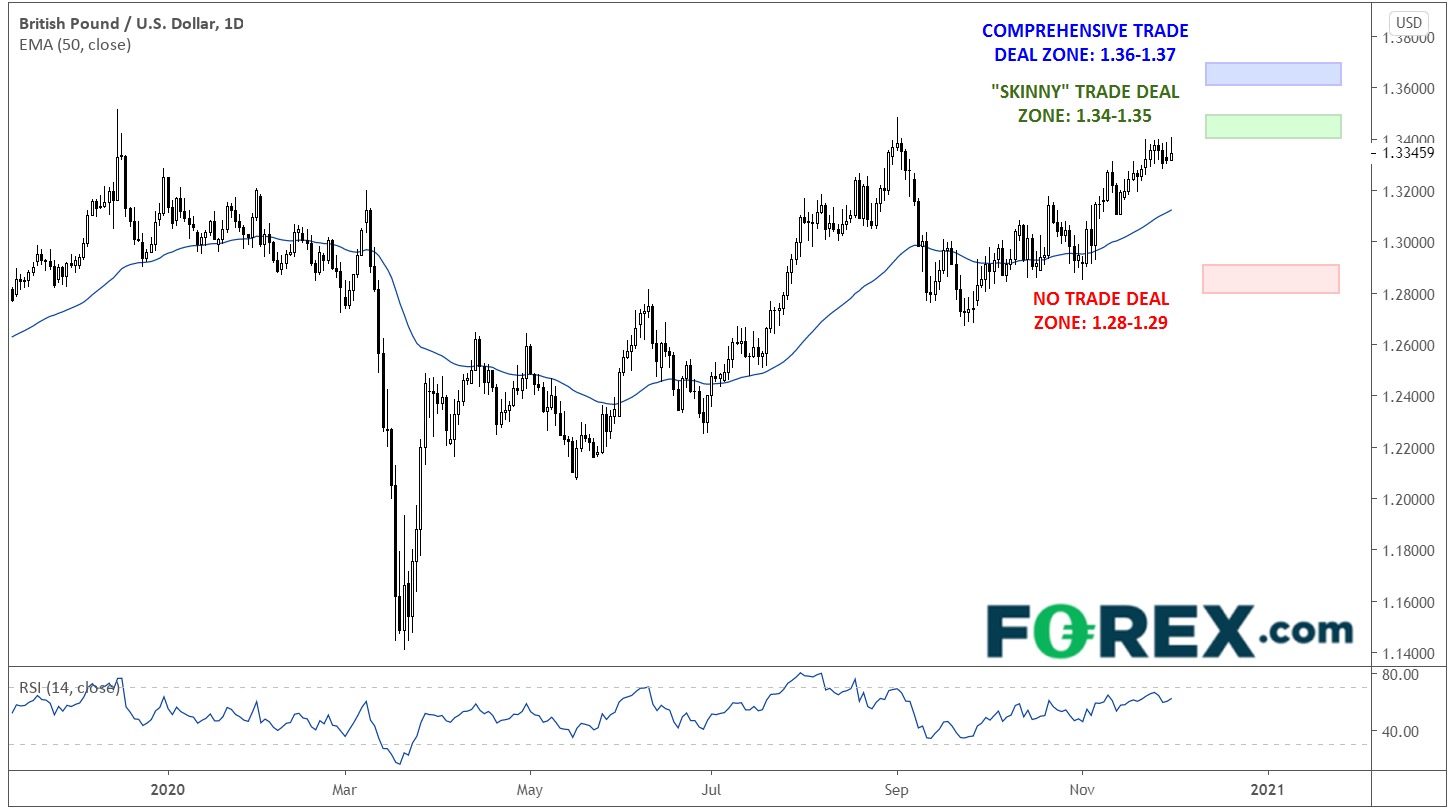Nearly four and half years on from the Brexit vote in June 2016, the finish line is finally in sight for the UK to formally leave the European Union. One way or another, the UK’s “transition period” will officially end on 31 December, though we’ve learned through experience that seemingly “hard and intractable” deadlines can be delayed repeatedly in the interest of expediency when it comes to Brexit.
In any event, negotiations are reportedly 95% done (it’s always that last 5% that’s the most difficult!), with the final sticking points relating to state aid, fair competition, fishing rights, and conflict resolution mechanisms. With the final European Council meeting of the year scheduled for 10-11 December, we’d likely need to see some serious progress by the end of this week to allow EU leaders to translate/review/agree on any arrangement.
From our perspective, we are likely to see one of three scenarios play out by the end of the year, with the associated estimated probabilities:
1. Comprehensive Deal (~20%) – Time is getting tight, but negotiators on both sides of the English Channel have publicly expressed support for a full, comprehensive trade deal. Given the lack of progress over the previous half-decade, traders are understandably skeptical that the two sides can complete a wide-ranging agreement in the next couple of weeks. That said, readers who are optimistic about the prospects of this scenario coming to pass may want to consider bullish trades on UK assets, with both the pound and FTSE poised to surge if a balanced, comprehensive deal is reached.
2. “Bare Bones” Deal (~50%)– In this scenario, UK and EU negotiators are able to cobble together a last-minute “skinny” trade deal, potentially with an extension of the transition period to minimize economic disruption. While the two sides would need to pay special attention to certain sectors (such as the UK’s large financial services industry), the market believes there’s still a path to such an agreement. That said, this is seen as the most likely outcome by traders and therefore may lead to less volatility (in other words, it’s relatively “priced in”). That said, the initial reaction to such an agreement would likely be moderately positive for UK assets as it would remove the major risk of the UK spinning out of the UK with no deal.
3. No Deal (~30%) – If negotiations take a turn for the worse in the coming days, odds of a disruptive no-deal, “hard” Brexit, where the UK reverts to the international trading rules set by the World Trade Organization (WTO), will rise. In 2019, the EU accounted for 43% of UK exports and about 50% of UK imports, so the imposition of new WTO tariffs and stricter border controls could tip the vulnerable UK economy back into recession in 2021.Traders still see this scenario as relatively unlikely, but it would certainly be very disruptive to the UK economy if it comes to pass. In terms of market moves, the pound would likely fall sharply, as would the FTSE (with banks and importers particularly vulnerable) as citizens and firms adapt to a dramatically different economic environment. Down the road, this scenario could also lead to the breakup of the United Kingdom, with support growing for both Scottish independence and a potential reunification of Ireland.
As we approach the end of the year, Brexit negotiations will be the most important factor for GBP and FTSE traders to watch. When it comes to GBP/USD, the pair has rallied nearly 2,000 pips off its pandemic (and post-Brexit-vote low) earlier this year, but a comprehensive deal with the EU could push the pair higher toward 1.3600 if the two sides can reach a comprehensive deal, while a surprise no-deal scenario could take the pair down toward 1.2900:
Source: TradingView, GAIN Capital
This research is for informational purposes and should not be construed as personal advice. Trading any financial market involves risk. Trading on leverage involves risk of losses greater than deposits.
Recommended Content
Editors’ Picks
EUR/USD edges lower toward 1.0700 post-US PCE

EUR/USD stays under modest bearish pressure but manages to hold above 1.0700 in the American session on Friday. The US Dollar (USD) gathers strength against its rivals after the stronger-than-forecast PCE inflation data, not allowing the pair to gain traction.
GBP/USD retreats to 1.2500 on renewed USD strength

GBP/USD lost its traction and turned negative on the day near 1.2500. Following the stronger-than-expected PCE inflation readings from the US, the USD stays resilient and makes it difficult for the pair to gather recovery momentum.
Gold struggles to hold above $2,350 following US inflation

Gold turned south and declined toward $2,340, erasing a large portion of its daily gains, as the USD benefited from PCE inflation data. The benchmark 10-year US yield, however, stays in negative territory and helps XAU/USD limit its losses.
Bitcoin Weekly Forecast: BTC’s next breakout could propel it to $80,000 Premium

Bitcoin’s recent price consolidation could be nearing its end as technical indicators and on-chain metrics suggest a potential upward breakout. However, this move would not be straightforward and could punish impatient investors.
Week ahead – Hawkish risk as Fed and NFP on tap, Eurozone data eyed too

Fed meets on Wednesday as US inflation stays elevated. Will Friday’s jobs report bring relief or more angst for the markets? Eurozone flash GDP and CPI numbers in focus for the Euro.
